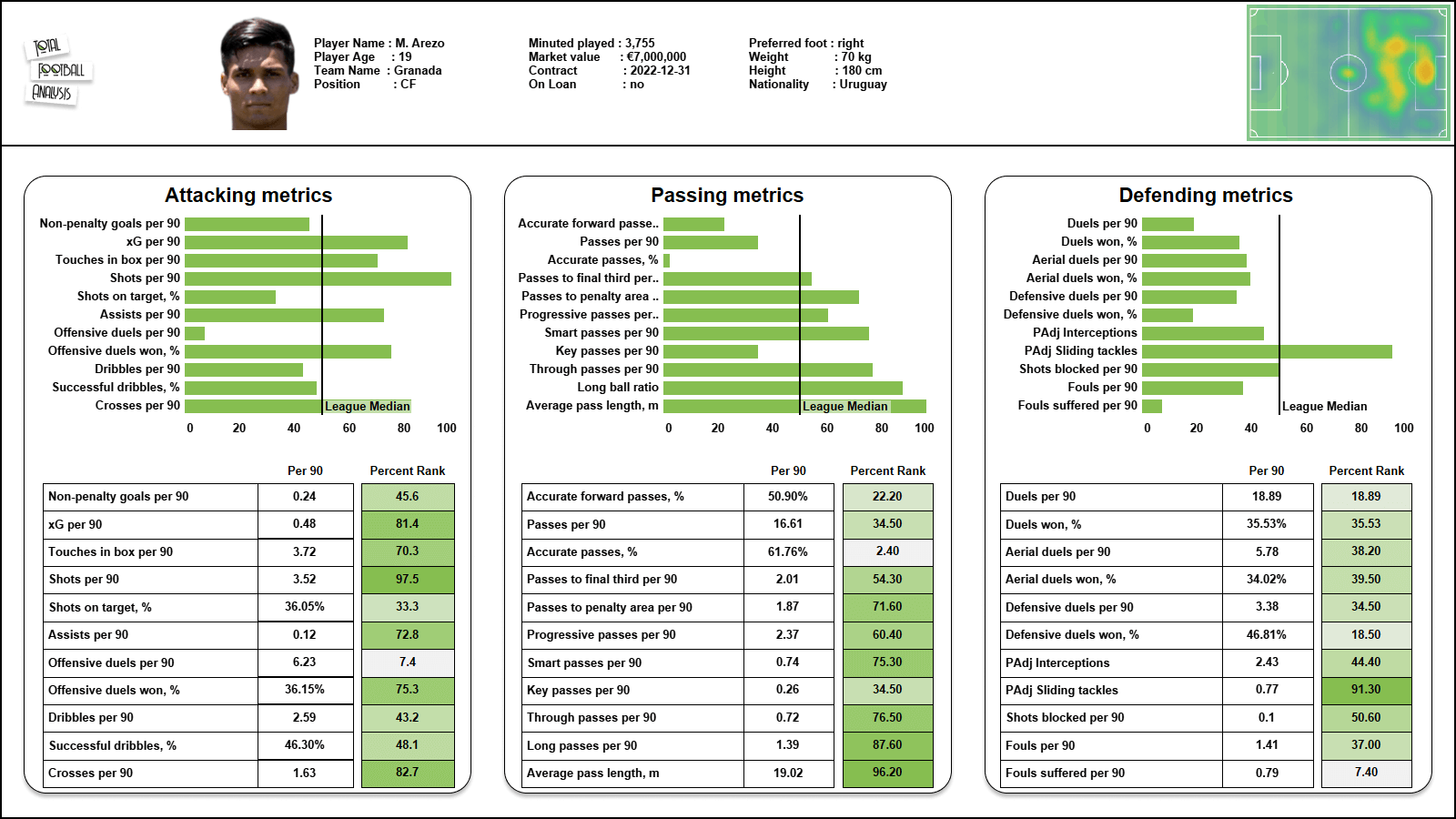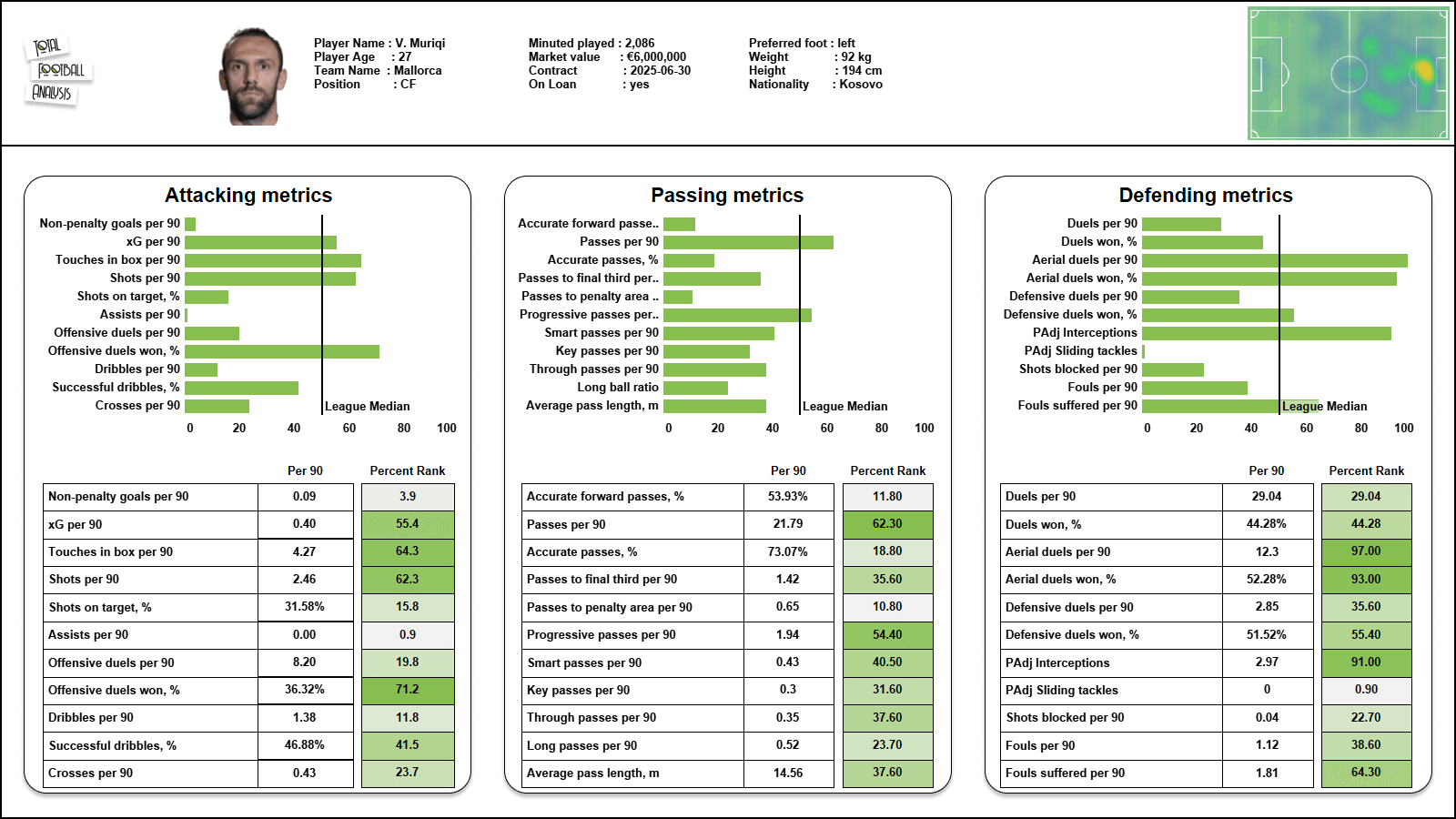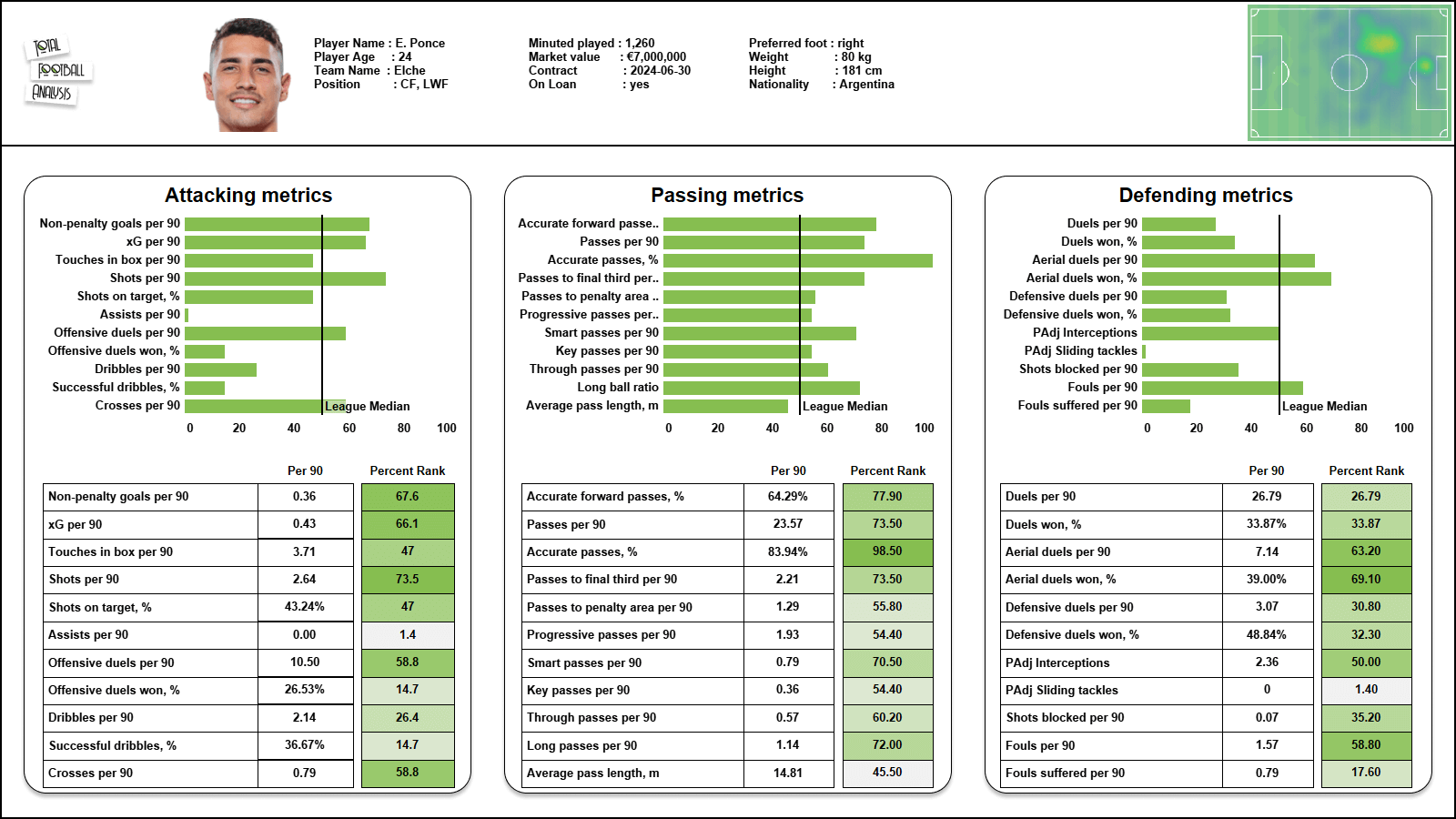Signing players in January has never been easy and even less when you look for strikers. Trying to add goals is the instinctive thing to do when things aren’t working but in a market where all teams look for the same, it’s often very difficult to find reliable options at a decent price.
This market window has been especially quiet in La Liga. Most teams are still readjusting their finances after the pandemics and only two teams – Barcelona and Granada – have spent more than €10m. However, there have been some interesting movements that could help some teams in the bottom half in their relegation battles.
In this data analysis piece, we’ll have a look at three new La Liga strikers whose signings may have gone under the radar and could change their new teams’ seasons. For each of them, we’ll provide a statistical profile with their data of the last calendar year and a scout report.
Matías Arezo – River Plate (URU) to Granada
Despite being in the 16th position, Granada’s situation isn’t as bad as it may seem. They’re six points away from the relegation positions and after a bad start of the season, the team is starting to perform better. They have played both games against Barcelona and Real Madrid too so their calendar is quite good.
However, the team coached by former Spain and Monaco coach Robert Moreno has been one of the most active ones in the January transfer window. Granada completed six signings and spent €10.5m, the second-highest amount behind Barcelona’s €55m. Their top signing was Matías Arezo (2002, Uruguay), for whom Granada paid €5m for 50% of his rights.
Arezo comes from River Plate in Uruguay, where club where he played since he was a kid. He made his debut for La Dársena in 2019 aged just 16 and since then, he has played 91 games, scoring 37 goals and providing 14 assists. He has played for Uruguay at U17, U20 and U23 levels (32 caps, 12 goals) but is still waiting for his first senior call up. He’s been considered one of the most promising players in Uruguay for some time now.

At his young age and despite his tendency to appear in the second line, Arezo is a striker that stands out for his scoring instinct. His 0.48 xG per 90 are in the top 20% among the strikers in the Uruguayan Primera División and his scoring record (0.45 goals per 90 in his senior career so far) only supports that. Arezo shoots every time he has the chance and his 3.52 shots per 90 put him in the top 2.5% of the league.
Standing at 1.80m / 5’11’’, Arezo doesn’t look like a teenager. He’s very well-built and his strength makes him a very difficult to stop player once he engages in duels. Winning 35.15% of his offensive duels, he’s in the top 25% of the league, even against defenders as tough as the Uruguayans. He uses this power to get past the last defender and get into the box and also to protect his position and create space to finish.
Regarding his goals, Arezo has a wide range of possibilities. He’s fast to run in behind and receive deep passes, can challenge the centre-backs to create his own chances, poaches goals at the far post and possesses a deadly shot from distance both in open play and set-pieces, maybe his most spectacular trait. He’s scoring 0.46 goals (0.24 non-penalty) from 0.48 xG per 90, which is especially good considering he shoots very often and not always from easy positions. Arezo is a skilled finisher who uses different parts of either foot depending on the situation and can go for power or accuracy depending on what each play demands.
Apart from his activity in the box (his 3.72 touches in the box per 90 are better than 70.3% of the strikers in Uruguay), Arezo offers a lot more. His work rate is excellent and he’s always making off-the-ball runs to stretch the rival defence and provide options for his team to progress with direct passes. He can drift wide and use his speed and strength to get past players when there’s some space.
Playing outside the box quite often, Arezo creates chances for his teammates too. He shows intelligence to play dangerous passes even if he’s not the most creative player. His 0.72 through passes, 1.87 passes to the box and 1.63 crosses are all over the 70th percentile and result in 0.09 xA and 0.12 assists per 90.
In Arezo, Granada get a young hard-working and powerful striker with an excellent scoring record and a deadly shot. His closest statistical match according to our exclusive xGold tool is Brentford’s Ivan Toney with an 88% similarity. Surely, Arezo will take some time to adapt to a much higher level of football but he has everything to be the next great Uruguayan striker.
Vedat Muriqi – Lazio to Mallorca
Just one position below Granada in La Liga table, we find Mallorca. The Balearic team is five points away from the relegation zone with one game in hand. They’re the second-lowest scoring team with just 19 goals in 22 matches and a new striker looked like the evident signing in January. The chosen one was Vedat Muriqi (1994, Kosovo), who arrives at Mallorca on loan from Lazio with a €12m option to buy.
Muriqi started his career at KF Liria in his home country before moving to Albania, where he played for Teuta and Besa Kavajë. Five goals in 31 appearances caught the attention of Giresunspor from the Turkish second division. In two seasons at the club, Muriqi scored 23 goals in 69 games and earned a move to the Turkish Süper Lig with Genclerbirligi Ankara.
He only scored 10 goals in 55 games in his first 18 months for Genclerbirligi so he moved back to the second division with Rizespor in January 2018 to relaunch his career. In his first six months there, Muriqi had eight goals in 16 games and achieved promotion. He continued his form with Rizespor in the Süper Lig with 17 goals in 34 games in the 2018/19 season, earning a move to Fenerbahce for €5.6m.
His 2019/20 season at the Turkish giants was fantastic, scoring 17 goals in 36 games and immediately progressing to the Italian Serie A with Lazio paying €20m for him. At Lazio, Muriqi couldn’t get too much playing time and only managed to score twice in 49 appearances (just over 1,500 minutes) so he was loaned to Mallorca.
Muriqi has been capped 37 times for Kosovo and became their top scorer ever with 18 goals.

Muriqi stands out for his size and presence in the box. Standing at 1.94m / 6’4’’, the left-footed striker is used as a target man in his team, winning 52.3% of the 12.3 aerial duels he contests per 90, both statistics in the top 10% among strikers in Serie A. His physicality also translates into offensive duels, winning 36.3% of them (71.2th percentile).
As we have seen, Muriqi’s scoring figures have been quite low at Lazio. The lack of confidence and playing time (he only started eight league games in his time in Italy) have resulted in him scoring just 0.09 non-penalty goals in the last calendar year. However, his underlying numbers suggest he’s not doing that bad. With 0.4 xG per 90, Muriqi is above average when it comes to getting chances so a boost of confidence and a fresh start could immediately result in him scoring at a good rate for Mallorca. His start has been perfect, scoring a winner in his first La Liga appearance against Cádiz.
But Muriqi isn’t only a big target man. His numbers at Lazio suggest he has some passing quality (1.94 progressive passes, 0.43 smart passes, 0.3 key passes and 0.35 though passes per 90, all close to the median) and again, a team that uses him better and where he feels more comfortable will bring the best out of him.
In his first La Liga game, Muriqie already proved he can play good first-touch layoffs and combinations, get the ball into dangerous positions around the six-yard box with intelligent passes and crosses, bring the ball down, hold it and win headers in the box. With Mallorca using him as the focal point of their attacks, Muriqi shined and showed all his qualities apart from his physicality.
Muriqi also has a good pace for his size, especially over long distances, so he can drift wide in counterattacks and make runs on and off the ball from there. This ability to run in behind and beat the last defender makes him a very complete striker.
With his current form, Muriqi’s most statistically-similar player in the top-5 leagues is Christian Benteke (82%), with Edin Džeko coming close (81%) according to xGold. Mallorca took the Kosovan giant in an attempt to get the player who shined at Fenerbahce. His start has been impressive and if he continues to adapt and feel an important piece of Mallorca’s attacks, he will surely impress and prove Lazio wrong. Back to the form he had in Turkey, Muriqi is a striker worth much more than the €12m of his buying option.
Ezequiel Ponce – Spartak Moscow to Elche
In the 14th position in La Liga and just three points above Mallorca, we find Elche. The Argentinian-owned club has in Lucas Boyé one of the most in-form strikers in La Liga but with Lucas Pérez and Darío Benedetto leaving for Cádiz and Boca Juniors respectively, they needed a new striker.
The chosen forward was Ezequiel Ponce (1997, Argentina), who signed for Elche on loan with an option to buy from Spartak Moscow. Ponce started his career at Newell’s in Argentina, making his debut at 16 and scoring five goals in 37 appearances, which convinced Roma to pay €4.2m for him when he was just 18. In his first and only season in Italy, Ponce played 11 games for Roma U19 and scored 10 goals but didn’t earn any senior opportunities.
Between 2016 and 2019, Ponce played on loan at Granada (2 goals in 27 games), Lille (3 in 32) and AEK Athens (21 in 43). In 2019, Spartak Moscow bought him for €3m and since then, he has played 73 games and scored 25 goals. Ponce started this season in the Russian Premier League in fine form, scoring four goals in seven appearances before injuring his meniscus. He hasn’t played since September 30.
Ponce was capped with Argentina at U20 level earlier in his career and in the last three years he has played eight games with Argentina U23, including two at the Tokyo Olympics.

Ponce is a striker with decent size (1.81m / 5’11’’) but still strong in duels and a powerful runner. His pace is good and he does well in the air thanks to his jumping power, winning 39% of his aerials (69.1th percentile).
He’s very insistent with his off-the-ball movements, constantly running in behind and diagonally to the wings both to receive the ball and to open spaces for his teammates. Once in the box, he attacks spaces with determination and is intelligent to find space between the centre-backs. Despite not being too active in the box (just 3.71 touches in the box per 90), he still shoots a lot (2.64 times per 90, 73.5th percentile) and from good positions (0.43 xG per 90, 66.1th percentile). His finishing hasn’t been especially good in the last year and he has underperformed his xG scoring only 0.36 non-penalty goals per 90.
His technique when he comes to the second line is good. He can control the ball and combine in tight spaces with either foot and likes to link up with the midfielders before attacking space from deep. His ability to combine and pass the ball can be appreciated in his passing accuracy of 83.94% (top 2.5%). Ponce plays for a dominant team and because of that, he gets a lot of chances to be creative with his passes, ranking above-average in lots of creative passing metrics. Even if he fits that, he doesn’t stand out for his chance creation and averages just 0.06 xA per 90.
He doesn’t usually dribble outside the box, which explains his low quantity and success rate. In the box, he has some nice technical details and uses his strong first meters to leave players behind. He also uses his body well to hold the ball and his layoffs are generally good so he can play as a target man and create space and time for his teammates.
Ponce is an aggressive player both in attack and defence. His work rate can be appreciated in his 2.36 possession adjusted interceptions and 1.57 fouls per 90 and he can be trusted to press and give a bad time to rival defenders.
According to xGold, Ponce’s most statistically similar player in the top-5 leagues is Chelsea’s Kai Havertz (90%) as he can also play up front or in the second line and contributes to his team attacks both with passes and shots. In Ponce, Elche get a player who has scored a lot in recent seasons in secondary leagues after a slow start in stronger leagues. He’s still young and can make it in La Liga, especially in a team full of fellow Argentinians in which he should feel at home and adapt immediately.





Comments